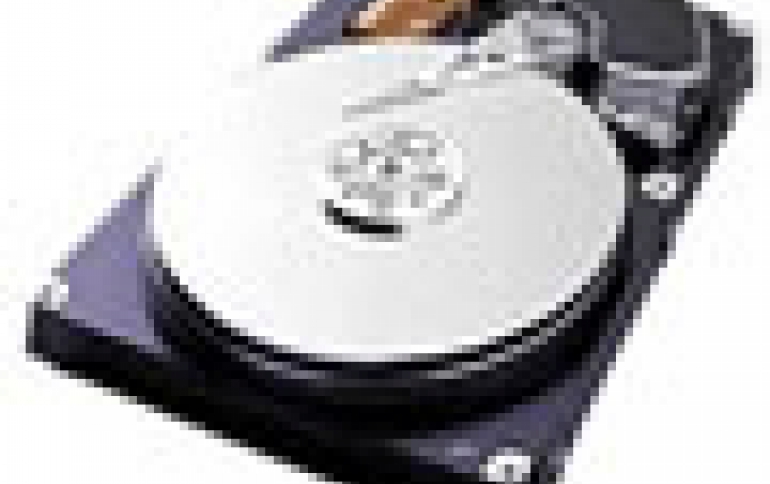
Samsung Showcases First Hybrid Hard Drive for Windows Vista
Samsung is exhibiting the first commercial prototype of a Hybrid Hard Disk (HHD) for notebooks and PCs that integrates NAND flash memory with rotating magnetic storage.
The HHD will be exhibited with two cache densities, 128MB and 256MB, at the Windows Hardware Engineering Conference (WinHEC) in the Seattle, WA Conference Center (Samsung booth #419) May 23-24, 2006.
"We see the HHD as the most advanced and cost-effective means of improving the performance of a notebook computer's storage functionality," said Jon Kang, senior vice president, technical marketing group, Samsung Semiconductor. "The Samsung HHD addresses the two biggest consumer desires: extending battery life and improving boot and resume performance."
Hybrid hard-disk drives include a flash-memory chip with enough capacity to store both data and applications. Current hard disk drives are used to store the operating system, applications, and all data. As a result, users often have to wait for some time for the computer to react to an input. A hybrid HDD will eliminate much of this source of annoyance, because its flash-memory component will handle all of the most-often-used data and applications. The hard-disk drive itself will remain asleep for 90 percent or more of the time, awakening only when demands are entered that the flash-memory module cannot handle. This will also reduce the power consumed by the computer.
The high densities of magnetic storage technology are preserved, while the low power, high reliability and fast read/write access of advanced NAND flash technology enhance overall value at minimal additional cost. With an HHD, consumers receive a system that boots or resumes up to twice as fast as conventional HDDs, lasts 20-30 minutes longer on battery and is up to five times more reliable.
"Hybrid hard disks and Windows ReadyDrive Technology are integrated advancements that improve the performance and reliability of computers using Windows Vista, especially notebook computers," said Mike Sievert, corporate vice president, Windows Client Marketing at Microsoft. "We are very pleased to see Samsung moving so rapidly with HHD technology to prepare for high-volume production in time for the Windows Vista launch."
The Hybrid Hard Disk also eliminates the need for the hard disk to constantly spin whenever a computer is operating on battery power, and is less susceptible to damage from jarring or being dropped since it is idle most of the time.
Every time the cache is filled, the rotating drive spins to "flush out" or transfer data from the cache, spinning only a few seconds every 10-20 minutes. The Samsung HHD architecture uses Samsung's OneNAND flash with 108MB/s read and 18 MB/s write data-rates. The functionality of the H-HHD is automated by the high performance HDD SOC which supports 3.0G Native Command Queuing SATA and an OneNAND interface. The HHD saves between eight and 25 seconds of boot-up time and extends battery life by about 8-10 percent depending on the model of computer, according to Samsung.
The first Samsung hybrid drives may be included in Samsung PCs as early as the second quarter of 2007, in conjunction with the Windows Vista rollout.
Other companies, including Intel, are also working on hybrid drive designs.
"We see the HHD as the most advanced and cost-effective means of improving the performance of a notebook computer's storage functionality," said Jon Kang, senior vice president, technical marketing group, Samsung Semiconductor. "The Samsung HHD addresses the two biggest consumer desires: extending battery life and improving boot and resume performance."
Hybrid hard-disk drives include a flash-memory chip with enough capacity to store both data and applications. Current hard disk drives are used to store the operating system, applications, and all data. As a result, users often have to wait for some time for the computer to react to an input. A hybrid HDD will eliminate much of this source of annoyance, because its flash-memory component will handle all of the most-often-used data and applications. The hard-disk drive itself will remain asleep for 90 percent or more of the time, awakening only when demands are entered that the flash-memory module cannot handle. This will also reduce the power consumed by the computer.
The high densities of magnetic storage technology are preserved, while the low power, high reliability and fast read/write access of advanced NAND flash technology enhance overall value at minimal additional cost. With an HHD, consumers receive a system that boots or resumes up to twice as fast as conventional HDDs, lasts 20-30 minutes longer on battery and is up to five times more reliable.
"Hybrid hard disks and Windows ReadyDrive Technology are integrated advancements that improve the performance and reliability of computers using Windows Vista, especially notebook computers," said Mike Sievert, corporate vice president, Windows Client Marketing at Microsoft. "We are very pleased to see Samsung moving so rapidly with HHD technology to prepare for high-volume production in time for the Windows Vista launch."
The Hybrid Hard Disk also eliminates the need for the hard disk to constantly spin whenever a computer is operating on battery power, and is less susceptible to damage from jarring or being dropped since it is idle most of the time.
Every time the cache is filled, the rotating drive spins to "flush out" or transfer data from the cache, spinning only a few seconds every 10-20 minutes. The Samsung HHD architecture uses Samsung's OneNAND flash with 108MB/s read and 18 MB/s write data-rates. The functionality of the H-HHD is automated by the high performance HDD SOC which supports 3.0G Native Command Queuing SATA and an OneNAND interface. The HHD saves between eight and 25 seconds of boot-up time and extends battery life by about 8-10 percent depending on the model of computer, according to Samsung.
The first Samsung hybrid drives may be included in Samsung PCs as early as the second quarter of 2007, in conjunction with the Windows Vista rollout.
Other companies, including Intel, are also working on hybrid drive designs.





















